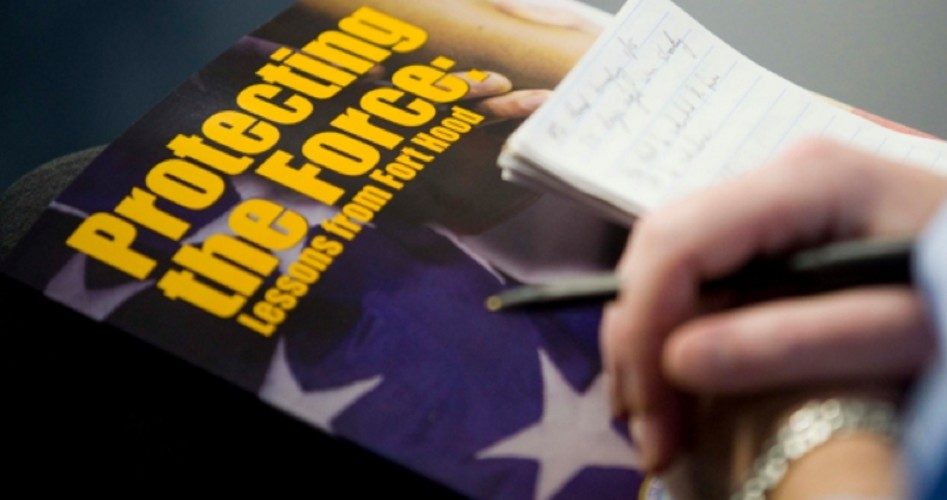
The parallels between the massacre of 13 soldiers by Major Malik Hasan at Fort Hood in 2009 and three soldiers there by Spec. Ivan Lopez on Wednesday afternoon are disturbing. Despite promises from officials, starting with the president on down, that nothing like this would happen again, it happened again. At about 4:30 p.m., Specialist Fourth Class Ivan Lopez entered a building on the Fort Hood campus, where he apparently became involved in an argument with another soldier. He pulled his recently purchased .45-caliber semi-automatic handgun and began firing.
He then left the building, got into his car, and continued shooting, apparently randomly, at other soldiers. He exited the car and was confronted by a female MP, whereupon he turned his weapon on himself.
In 2009, Hasan entered a building (which has since been demolished) where soldiers were getting their final medical checks prior to being shipped to Afghanistan. Shouting “Allahu Akbar!” (Arabic for “God is great”), Hasan opened fire using recently purchased firearms. The shooting lasted for 10 minutes, during which time he had to time to reload and continue the massacre. In August 2013, after a brief trial, Hasan was convicted of murder and sentenced to death. He remains in jail during the appeal process, which could last months, perhaps even years.
The similarities and differences in the two attacks are striking and instructive. In Hasan’s case, there were clues that he was becoming a threat, but the danger he posed was either ignored or only became evident after the massacre. He had even e-mailed back and forth with known Muslim terrorists.
In Lopez’s case it is clear that he was mentally unbalanced, having been treated for depression just a few days before Wednesday’s massacre. Some have suggested he was suffering from PTSD following a brief stint in Iraq in 2011, but he served in a support position, not on the front lines.
In Hasan’s case his attack was ended by a local police officer, while Lopez’s ended when confronted by an MP. In neither case were the criminal attackers confronted by their victims with deadly force. That deadly force came from elsewhere.
In each case the weapons used by the attackers were purchased at a local shop after each man had successfully passed the highly vaunted criminal background check.
In both cases the White House response was the same. In 2009, President Obama “asked every agency involved … to investigate why this happened, how this happened, and to ensure that they can tell [me] that it won’t happen again.”
On Wednesday, the president said, “My security team is … working … to determine exactly what happened…. We want to assure [everyone that] we are going to get to the bottom of what happened…. We don’t yet know what happened tonight but obviously that sense of safety has been broken once again. We need to find out exactly what happened.”
Defense Secretary Chuck Hagel was equally clueless about the “what, why, and how” of the latest massacre at Fort Hood: “Obviously, when we have these kinds of tragedies on our bases, something’s not working.”
What isn’t working is any reasonable comprehension of the evils of human nature and how targets, confronted with that evil but not allowed to exercise their right to self-defense, become victims.
In their massive study of multiple victim public shootings, professors John Lott and William Landes examined data from 1977 through 1995 and concluded:
Our results find the only policy factor to have a consistently significant influence on multiple victim public shootings is the passage of concealed handgun laws….
These laws reduce the number of shootings and have an even greater effect on their severity.
Thanks to a bill signed into law in 1993 by then-President Bill Clinton, the soldiers at Fort Hood were sitting ducks in 2009 and remain sitting ducks today. Under that law they are not allowed to carry personal firearms while on base. That law, in essence, turns Fort Hood — a training center for 50,000 soldiers with the 1st Cavalry Division and the 4th Infantry Division — into a “criminal safe” zone, a perfect place for Hasan and Lopez to work their evil.
Under the new guidelines, issued since the first Fort Hood attack, warnings to “shelter in place” were given, along with instructions to stay indoors, lock the doors, and stay away from windows.
When Lisa Pfund, one of those unarmed targets who became a victim in 2009, heard about the attack on Wednesday:
I went on Facebook and I thought, “Not again. It shouldn’t have happened again. I thought things were put in place where it wouldn’t happen again.”
Until common sense is restored, massacres such as this will continue to happen and continue to surprise those who have repeatedly promised that they won’t happen again.
Photo: AP Images
A graduate of Cornell University and a former investment advisor, Bob is a regular contributor to The New American magazine and blogs frequently at www.LightFromTheRight.com, primarily on economics and politics. He can be reached at [email protected].



